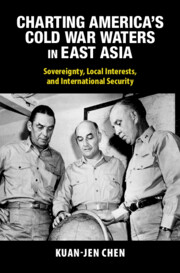 Charting America's Cold War Waters in East Asia
Charting America's Cold War Waters in East Asia Published online by Cambridge University Press: 23 May 2024
The interservice competition for leadership in the Pacific made it impossible for Washington to reach a consensus on strategic deployment in maritime East Asia. What really brought about the US Navy’s renouncement of its mainland-based strategy and its subsequent adoption of an offshore defensive perimeter was not the achievement of a consensus with the other services but the Chinese Communist Party’s occupation of the whole of mainland China in 1949. At this point, the United States had no choice but to withdraw all its naval forces from Qingdao, which had been the emblem of the Navy’s forward-deployed, offensive, and mainland-based strategic thinking in East Asia. China’s split across the Taiwan Strait left the structure of international politics in maritime East Asia indeterminate.
To save this book to your Kindle, first ensure [email protected] is added to your Approved Personal Document E-mail List under your Personal Document Settings on the Manage Your Content and Devices page of your Amazon account. Then enter the ‘name’ part of your Kindle email address below. Find out more about saving to your Kindle.
Note you can select to save to either the @free.kindle.com or @kindle.com variations. ‘@free.kindle.com’ emails are free but can only be saved to your device when it is connected to wi-fi. ‘@kindle.com’ emails can be delivered even when you are not connected to wi-fi, but note that service fees apply.
Find out more about the Kindle Personal Document Service.
To save content items to your account, please confirm that you agree to abide by our usage policies. If this is the first time you use this feature, you will be asked to authorise Cambridge Core to connect with your account. Find out more about saving content to Dropbox.
To save content items to your account, please confirm that you agree to abide by our usage policies. If this is the first time you use this feature, you will be asked to authorise Cambridge Core to connect with your account. Find out more about saving content to Google Drive.